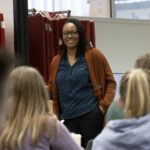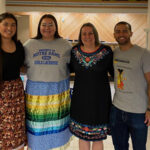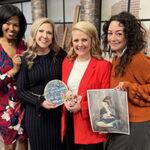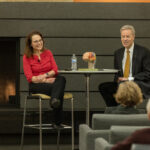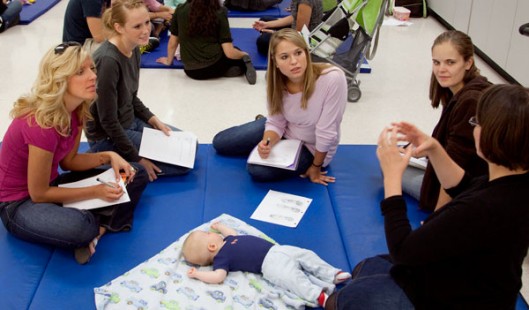
As any baby’s parent will tell you, YouTube may be great – but nothing compares to experiencing a little one in “real time.”
Cindy Clough agrees. She initiated a “Baby Day” lab for her Occupational Therapy in Pediatrics I Class so her students could learn about infant development through direct observation. While she uses videos in her teaching, Clough insists that nothing compares to (literally) hands-on experience.
Last fall, six babies and their caregivers came to a specially designed class. Students were divided into teams and filled out worksheets about their observations.
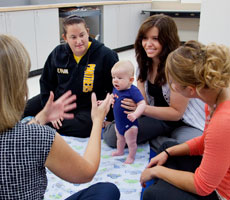
Clough is a clinical instructor in the Department of Occupational Science & Technology and OT undergraduate program coordinator in the College of Health Sciences. She says an understanding of baby’s abilities and behavior is critical for pediatric OTs.
“Occupational therapists (OTs) who work with children must have an in-depth knowledge of child development. In addition to motor skills, OTs need to understand infant attachment, social-emotional development, sensory skills and cognitive development.”
Baby basics are the stuff of OT
Not everyone is familiar with the work of pediatric OTs. Clough explains that the “occupational” in occupational therapy is sometimes confused with “vocational,” but OTs work with clients ranging from babies in the neonatal unit of a hospital to retired seniors. “Occupational” refers to the activities that people engage in every day – for the tiniest infants that is feeding, bonding, developing motor skills, and self regulation.
In the College of Health Sciences, there are two, one-semester courses in pediatric practice required for OT students. The first semester focuses on “typical” development and various medical and social developmental conditions, while the second semester covers how to provide interventions for children with disabilities.
“If students don’t know what ‘typical’ is, they can’t judge what to be concerned about,” says Clough. “Some kids are borderline. The better you understand the range, the better you know when to throw the proverbial red flag. The current emphasis on early intervention makes it particularly important for OTs to know the benchmarks of early development, so they can identify signs of autism or developmental delays,” says Clough.
Baby Day also give students important exposure to working with parents.
“It’s vital that students learn how to connect with parents – how to pose questions and how to respond to parents’ concerns. The students also observe how a parent and child interact in terms of contact, socialization, coping skills and stranger shyness,” says Clough
Baby-watching boosts professional skills
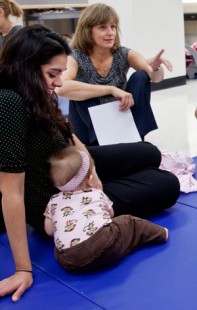
“Interacting with the babies and their caregivers on Baby Day was a very enjoyable experience,” says senior student Murphy Mangan. “We were able to make silly faces and play on the floor, all in the spirit of learning, As we competed to win the attention of each child, we also observed developmental milestones that we learned about in class. Seeing those concepts in real-life created a much stronger understanding of child development.”
Mangan also appreciated being able to interact with the mothers who attended.
Emily Whitlock, also a senior in CHS, says that the team members took extensive notes on the performance areas to understand what stage of development an infant was experiencing, which honed their skills in occupational therapy documentation.
“The list of items that we were supposed to observe, the fine details that we witnessed, as well as the variation between the different children, greatly expanded my knowledge of how to assess children,” explains senior student Jennifer Hardy.
The babies, ages 11 months or younger, were recruited from the ranks of CHS faculty, staff and students.
“That’s helpful because the parents knew about teaching labs, were familiar with what the students would be looking for and realized that students would be picking up their babies,” says Clough. She emphasizes that safety and hygiene standards – frequent hand washing, liberal use of hand sanitizers and having babies use their own toys – are carefully taught and followed.
During the first semester, Clough also had three mothers of children with disabilities speak with the class, along with their children. The parents discussed raising their children and how they advocate for them. The class also has frequent guest lecturers from the OT field. A recent panel included representatives from health care providers who discussed early intervention and best practices.
